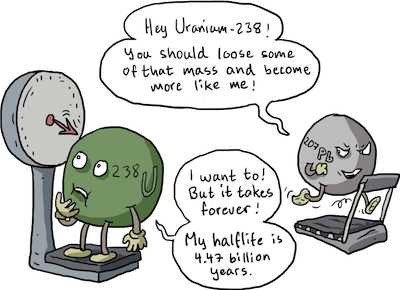Molecular Mass
Now that we know all about atomic masses we can move on to bigger and better things…molecules. (Maybe not better. We don't want to offend all the atoms out there.) If we know the atomic masses of individual atoms, we can easily calculate the mass of a molecule. The molecular mass (sometimes called the molecular weight) is just the sum of the atomic masses in a molecule.

What's the molecular mass of water (H2O)? To calculate the molecular mass we add together the atomic mass of two hydrogen atoms and one oxygen atom:
molecular mass H2O = 2(atomic mass of H) + atomic mass of O
Where do we find the atomic mass of H and O? Whip out your favorite periodic table. We know, we heart the periodic table, too.
molecular mass H2O = 2(1.008 amu) + 16.00 amu = 18.02 amu
From the molecular mass we can determine the molar mass of a molecule. Just as the name suggests the molar mass is the mass (in grams) of one mole of a compound. We don't even need a calculator to compute between molecular mass and molar mass…the values are numerically the same. The molar mass of a compound (in grams) is numerically equal to its molecular mass (in amu).
We just calculated the molecular mass of water to be 18.02 amu. Lucky for us (thanks again to the chemistry gnomes), its molar mass is 18.02 g. That means 1 mole of water is equal to 18.02 g.
Let's put this stuff into perspective. Roughly 1.2 tablespoons of water is equal to 18.02 grams. Those 18.02 grams represent one mole of water. That means every 1.2 tablespoons of water contains 6.023 x 10¬23H2O molecules. Think about that next time you down a glass of water. Who knew we were drinking so many molecules?

Methane = CH4
First of all, we are given grams of CH4 and asked to solve for moles of CH4. This means we need a conversion factor between grams and moles. Once again, the periodic table is your BFF. We need to collect the atomic masses of carbon and hydrogen from the periodic table and then calculate the molecular mass of CH4 by simple addition.
Molar mass of CH4 = atomic mass carbon + 4(atomic mass of hydrogen)
Note: we multiply by 4 because there are 4 hydrogen atoms in each CH4.
Molar mass of CH4 = 12.01 g + 4(1.008 g)
Molar mass of CH4 = 16.04 g
Therefore our conversion factor is:

What gives? Why do we need two conversion factors? We don't. We just need to use the conversion factor that will give us the right units in the end. Remember, if a unit appears above and below the fraction line they will cancel each other out. We need to arrange the conversion factor in whichever way will allow us to do that.
To solve we now write:

We're officially masters of molecular masses.

What's the molecular mass of water (H2O)? To calculate the molecular mass we add together the atomic mass of two hydrogen atoms and one oxygen atom:
molecular mass H2O = 2(atomic mass of H) + atomic mass of O
Where do we find the atomic mass of H and O? Whip out your favorite periodic table. We know, we heart the periodic table, too.
molecular mass H2O = 2(1.008 amu) + 16.00 amu = 18.02 amu
From the molecular mass we can determine the molar mass of a molecule. Just as the name suggests the molar mass is the mass (in grams) of one mole of a compound. We don't even need a calculator to compute between molecular mass and molar mass…the values are numerically the same. The molar mass of a compound (in grams) is numerically equal to its molecular mass (in amu).
We just calculated the molecular mass of water to be 18.02 amu. Lucky for us (thanks again to the chemistry gnomes), its molar mass is 18.02 g. That means 1 mole of water is equal to 18.02 g.
Let's put this stuff into perspective. Roughly 1.2 tablespoons of water is equal to 18.02 grams. Those 18.02 grams represent one mole of water. That means every 1.2 tablespoons of water contains 6.023 x 10¬23H2O molecules. Think about that next time you down a glass of water. Who knew we were drinking so many molecules?
Sample Problem
One of the main components of natural gas is methane (CH4). How many moles of CH4 are present in 4.83 g of CH4?
Methane = CH4
First of all, we are given grams of CH4 and asked to solve for moles of CH4. This means we need a conversion factor between grams and moles. Once again, the periodic table is your BFF. We need to collect the atomic masses of carbon and hydrogen from the periodic table and then calculate the molecular mass of CH4 by simple addition.
Molar mass of CH4 = atomic mass carbon + 4(atomic mass of hydrogen)
Note: we multiply by 4 because there are 4 hydrogen atoms in each CH4.
Molar mass of CH4 = 12.01 g + 4(1.008 g)
Molar mass of CH4 = 16.04 g
Therefore our conversion factor is:

What gives? Why do we need two conversion factors? We don't. We just need to use the conversion factor that will give us the right units in the end. Remember, if a unit appears above and below the fraction line they will cancel each other out. We need to arrange the conversion factor in whichever way will allow us to do that.
To solve we now write:

We're officially masters of molecular masses.